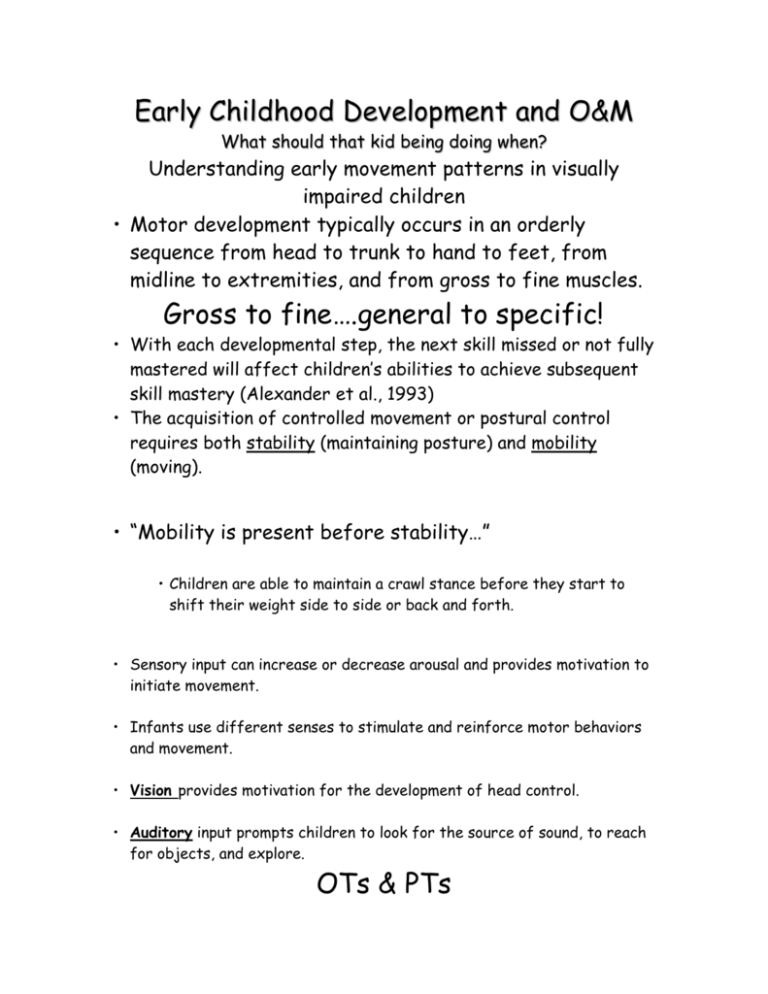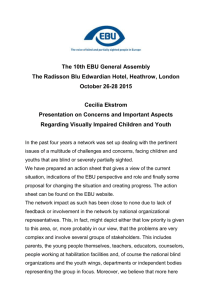Early Childhood Development and O&M
advertisement

Early Childhood Development and O&M What should that kid being doing when? Understanding early movement patterns in visually impaired children • Motor development typically occurs in an orderly sequence from head to trunk to hand to feet, from midline to extremities, and from gross to fine muscles. Gross to fine….general to specific! • With each developmental step, the next skill missed or not fully mastered will affect children’s abilities to achieve subsequent skill mastery (Alexander et al., 1993) • The acquisition of controlled movement or postural control requires both stability (maintaining posture) and mobility (moving). • “Mobility is present before stability…” • Children are able to maintain a crawl stance before they start to shift their weight side to side or back and forth. • Sensory input can increase or decrease arousal and provides motivation to initiate movement. • Infants use different senses to stimulate and reinforce motor behaviors and movement. • Vision provides motivation for the development of head control. • Auditory input prompts children to look for the source of sound, to reach for objects, and explore. OTs & PTs • Working with an OT or PT who can analyze and assess atypical movement is useful to COMS/L and families. • Therapists can recommend specific motor activities to assist the child in developing the movements needed to master the lagging skill (rolling, crawling, walking, etc.) • These activities can be enhanced with suggestions from COMS/L and TVIs that would facilitate awareness of surroundings, security in moving through space, etc. • Sighted child 1-2 Months - begins to lift head against gravity while prone (prone on elbows) - begins to have a visual interest in objects and actions • Visually impaired child - has difficulties being prone on elbows - the child is interested in play on the body, physical handling and rhythms. • Sighted child 3-5 Months - begins to have symmetry in their movement - begin visually directed reach, first with one hand then two -head control improves and the child begins • Visually impaired child - has more symmetry in movement - typically avoids prone positioning. to roll. - Head control improves while sitting (likes to be on their back). - Hands tend to be lightly fisted. • Sighted child 6-8 Months - sits independently (propped). - the grasp, release and transfer toys begins - creeping and crawling begin. • Visually impaired child - will be able to sit independently (propped). - They will begin to hold objects placed in their hand. they will mouth them and sometimes just release the item. - They may begin to move from sitting to lying on their back. limited crawling. • Sighted child Sometimes - There is 9-11 Months - will pull to stand with minimal assistance - can sit to stand and stand to sit. - Stands alone momentarily and begins walking. • Visually impaired child - will pull to stand with minimal assistance. - child may stand on their toes for several months. the transitional movements well. - may start goal-directed movement through space they are encouraged. • Sighted child - manages if 12-14 Months - walks with one hand held or independently. - child will choose to walk or crawl. - child can also move on and off of furniture. • Visually impaired child - will walk indoors with one hand held. continues and the child may cruise on furniture. - some children may skip the crawling as a way to - crawling move. • A sighted child 15-18 Months - Walks independently on level surfaces - Begins to negotiate indoor declines and declines, but still needs help with steps. - Learning simple routes. • A Visually Impaired Child - Walks independently on level surfaces - Searches with hands - limited exploration of unfamiliar environments. • • Sighted Child - 21-24 Months Manages stairs with little assistance Running begins Using push and pull toys Spinal Posture has developed Visually Impaired Child - Manages stairs with assistance - walks independently – familiar settings - learns simple routes 36 Months • Sighted child - runs, kicks, and jumps - alternates feet when climbing stairs • Visually Impaired child - Travels indoors independently - not yet running, kicking, or jumping. How To • Prior to about 7 months the COMS/L is not very actively involved with the child’s team. • Basic play schemes. • Introduction of “tools” • Family become familiar with blindness and O&M outcomes. The importance of O&M play • Play provides the opportunity for children to practice new cognitive, social-emotional, and physical skills. • Play offers numerous opportunities for children to act on objects and experience events. • Babies learn to turn the pages of books and begin to sense a sequence to the story. • Play is an active form of learning that unites the mind, body, and spirit (Levy 1978). Until at least age 9, children’s learning occurs best when the whole self is involved. • Play enables children to use their real experiences to organize concepts of how the world works/operates. • Through play, children can see how new experiences are related to previous learning. • As they play, blind/VI children can develop a playful attitude and are open to a variety of problem solutions. • Art appreciation can develop through tactual play. When the blind/VI child makes a clay pot, then he is a potter. • Play increases a blind/VI child’s curiosity, invention, staying with the task, and feeling successful. • Play reduces tension. Often blind/VI children are pushed to “achieve” or are “needing” to learn. In play, adults do not interfere. • Play challenges yet does not punish for mistakes. • If peers/siblings are involved the child develops skills for taking in another’s point of view, cooperating, helping, sharing, and solving problems together. Team work! • Children express and work out emotional aspects of everyday experiences as well as frightening events, especially through dramatic play. O&M concepts of motor and supporting play • Let child choose their activities. Provide a variety of toys, activities, and materials, but let the blind/VI child decide which ones he wants to “explore”. • Let the child determine length of play time. • Pushing children to continue with an activity that no longer holds their interest is likely to lead them to avoid that activity or skill in the future. • When the COMS/L interrupts play and exploration prior to the child feeling finished with the activity, it could interfere with the development of attention span. Preschoolers need notification that play time will end in 2 mins or 5 mins, so they can finish up. • Provide activities/materials that challenge various motor skills and levels. • Makes sure the physical environment is safe. • Arranges space so as to minimize interruptions. • Allows blind/VI children to use objects and try out new skills in unusual ways and/or as they are intended. • Challenges the level of play by suggesting more advanced props (pre-cane materials). Helping babies play -birth to 4 months- • Provide bright, moving objects for the blind baby to see/hear. • Move objects in/around around the baby. This will make a different visual/auditory impact. It helps babies judge the relationship between objects and between themselves and objects. • Hold babies up to your shoulder and move them around to provide more sensory input. • Playfully engage the baby in repetitions. • Stop between sounds and watch for them to smile or move. • Sing. Sing-song. • Dance. • Play with baby’s hands and • Feet. Four to 8 months • Keep toys safety a primary concern. • Toys that move or make sound in response to the baby’s action are best! • Minimize interruptions to protect babies’ exploration or new objects. Eight to 12 months • • • • Container play, dump tables, water play, baskets, shoe boxes. Hide and seek with objects and sounds. Read a book to them. Provide toys that challenge the toddlers motor skills. Begin some riding toys. • Stretch the toddler’s arms above head… playing Yoga. Twelve to 18 months • Provide simple pictures/objects of familiar items for toddler to name. • Provide for a safe place to travel (indoors and outdoors). • Increase motor opportunities – tunnels, cabinets, drawers, etc. • Provide real objects for daily activities such as eating, bathing, riding, and cleaning. These are also important toys for “pretend” play. Eighteen months to 3 years. • Provide equipment to challenge gross motor skills. • Provide objects that relate to each other. • Allow the B/VI child to try it in his own way. – Push toys, riding toys, rocking the rocking boat, climbing stairs, sliding down short slides, and crawling through tunnels. How COMS/Ls play games with children… • Keeps the focus on fun of playing not on winning. We are learning new skills, here. • Does not offer prizes of rewards for learning. – Sometimes this takes away from the development of self-motivation. • • • • Keep the child active. Introduces new skills or devices. Stays flexible on rules. Considers the overall ability of the child. Other areas incorporated into O&M play. • Pre-cane skills. Staying on task. Maintaining a route. Searching for dropped objects. Listening skills. Turntaking. Building relationships. Conclusion • O&M play helps the b/VI child integrate into the motor world. Simply describing what a place will be like or what will happen is not enough. • Be sure to enjoy your b/VI student!







